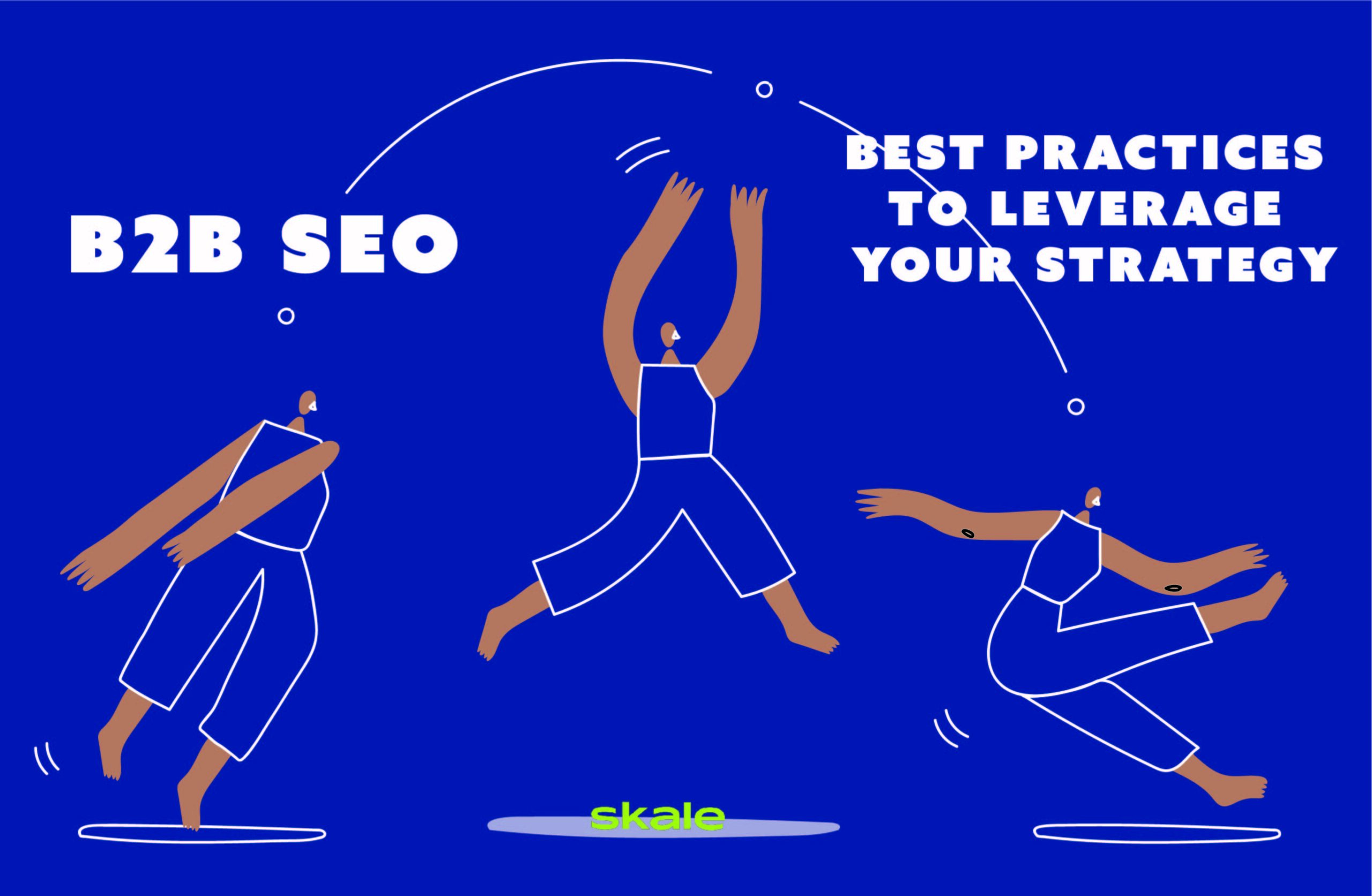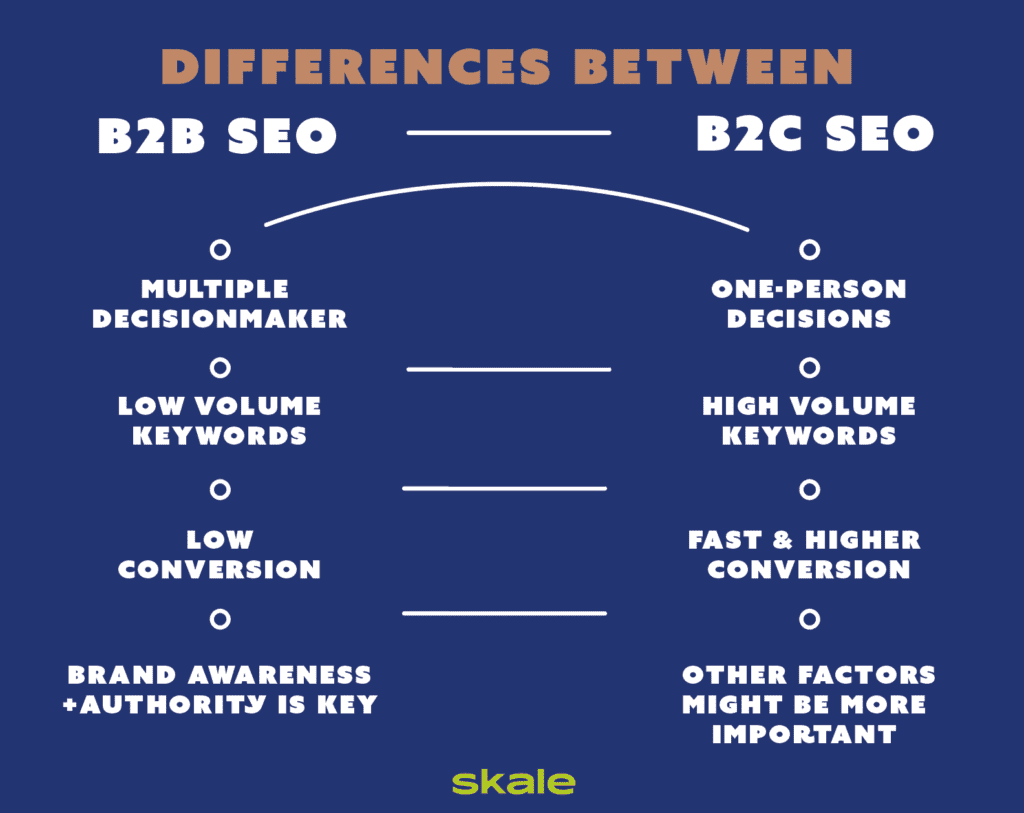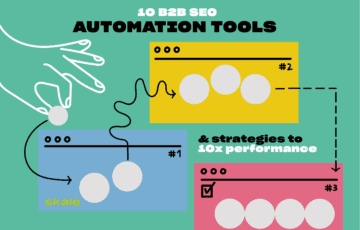
The Power of Partnership: 7 Benefits of Hiring a B2B SEO Agency
These benefits of hiring a B2B SEO agency illustrate why outsourcing your content can help you to drive new revenue for your business.


Level up your SEO strategy with Skale
See where Skale’s SEO experts can take your MRR. Get in touch, today
Contact UsWithout a strong B2B SEO strategy, you won’t be able to seize everything that SEO has to offer. You probably already know that SEO for B2B and B2C are completely different, but what are the practices that will help you make the most of SEO for B2B? Don’t worry, we’ll tell you.
In this article, we will look at the most important practices that’ll help your B2B business really outrun the competition and get the deserving first place on Google–or any other search engine.
Let’s see how you can make a flawless strategy that gets you where your users are looking.
Ready to make it on top of Google mountain? Let’s do this.
Search engine optimization is what allows your amazing content to be found by your target audience. It’s the science that works like the most accurate dating match: finding the perfect couple between your content and your ideal customer–a match made in marketing heaven.
However, despite brands knowing its importance and probably using it in their strategies already, most are not seizing it the way that is possible.
Why?
Various reasons, probably, and going through a recession doesn’t help, is that it’s hard to show its return on investment. But, trust us, SEO for B2B can be your go-to channel for your customer acquisition strategy, and it can truly show its worth.
When done correctly SEO can help you gain trustworthiness, brand awareness, and build thought leadership. After all, in B2B content, readers aren’t looking to be entertained, or see one article of yours before they make a decision. No. They want to know you are a reliable source, that you know and understand their problems, and that you’re an expert in the subject.
SEO is based on three pillars that work together to get you to the top of the search results. Those pillars–which we will discuss how to make work for you–are:

To really understand why a B2B SEO strategy is so important for businesses and how to make it work there are three key things we need to understand.
First, different from B2C where you’re targeting the person that will probably make the final decision of buying your product, in B2B you have multiple decision makers to convince. This also means there is a lower conversion rate than in B2C. B2B SEO is about the long game, not the quick wins.
Second, in B2C, the more people that see you, the better. Instead, in B2B you want your specific target audience to see you. So, the quality and targeting of your readers are better, not the quantity. This is why sometimes you’re better off targeting low-volume keywords, rather than high-volume ones if they are highly specific to your ideal customer profiles (ICP).
Third and last, in B2C your brand is important, but in B2B it’s crucial. In B2C, someone might buy a pair of headphones just because they are cheap enough, regardless of the brand they are. Instead, in B2B and due to the long line of decision makers that usually have a say before purchase, your brand and your thought leadership are essential for them to make a decision.
Here are some important B2B SEO statistics to look at:
Getting to the top search engine results pages will always be a priority for businesses. To do this, you’ll need to create useful content and custom-made B2B SEO strategies.
By using the right B2B SEO strategies you’ll be able to:
Now that we’ve seen why it’s so important, let’s see how you can develop a bulletproof strategy.
According to HubSpot, Google’s search algorithm uses more than 200 factors to rank websites. This means that getting on top of the results is not an easy feat. However, it isn’t impossible–just look at this result and how we’ve managed to be at the tippy top of the results page.
Here are the 8 B2B SEO best practices you need to include in your B2B SEO strategy to make sure you’re doing everything you can to succeed:
Unlike social media, where you’ll be shown things that might be interesting to you and you’ll actually end up following more than ten accounts of cute puppy dogs–without you ever intending to use Instagram like that. In SEO, it is all about user intent.
If you’re not showing the user what it is they’re looking for, they’ll either leave your site as quickly as they got in or simply scroll on by.
Creating ICPs should be your first step when designing a winning B2B SEO strategy which is an abstract representation of who your ideal customer is. It’s made based on quantitative and qualitative data from thorough market research.
Of course, most businesses will have a set of different buyer personas as they are not catering to only one type of customer. The more specific you can go with each, understanding their pain points at different stages of the buyer’s journey, their online behavior, and more, the better you’ll be at creating an SEO strategy that addresses each of their needs at the stage of the journey they’re currently in.
Now that you understand who your ideal customer profiles are and you’ve set up your buyer personas, you’ll need to focus on keyword research.
Keywords are one of the main elements that will let search engine crawlers know what your site and content are all about. Additionally, keywords are how people communicate to search engines what they want. After all, that’s what you’re typing into the search bar.
There are a few things to consider when doing keyword research:
To name just a few keyword research tools you have:
You can have great content, but if the keywords you’re using on your titles, meta description and copy do not match the search intent, you’ll be wasting your time.
Keep in mind that related keywords are also important to consider. If you fill everything with just one main keyword, Google won’t be as impressed. Instead, if you’re talking about SEO and you mention things like:
Google will see all of these related keywords as a sign that you really are talking about SEO and that you know your stuff.
We know it all sounds a bit daunting but fear not. It’s possible to have great keyword research and an optimum SEO strategy with the right tools and knowledge. However, if you want to leave SEO in the hands of the experts. Check us out–a B2B SEO agency created to do all the heavy lifting for you.
“Content is king, but only when quality is the cloak it wears.”
This means that unless you have a well-thought-out content marketing strategy and execution, your SEO strategy will only take you so far.
How do you make sure you have a killer content strategy?
Content creation is not easy, but it will be easier if you focus on providing value to your users. After all, in B2B you aim to prove you’re a thought leader in a specific problem and that you understand better than them the problems they are having.
When you focus on doing these things, and you pay attention to what users like in terms of images, white space, and whatever is working for your competition, you’re staying on top of your content SEO.
Google and other search engines don’t disclose every single factor they use in their algorithm. However, increasing the accessibility of your site will always be a good idea.
We don’t mean only accessibility for those with some type of visual impairment–e.g. colorblindness for example–but the general accessibility of your site for crawlers and humans.
Accessibility checklist to make sure your content is as accessible as possible:
If you’re in the SaaS industry and you want to learn more about how to make SEO-friendly content. Check our Best SaaS SEO Checklist for Creating Optimized Content.
Checking the competition is a key aspect of SEO. After all, if you’re trying to compete for that first page, you need to see what they’re doing that’s working, and how you could improve on it.
Obviously, you’re always aiming to provide original content. However, noticing the gaps that there are between your competitors’ content marketing strategy and yours is essential to understand what you could be doing better.
If you want to dig deeper into how to conduct an insightful competitor analysis. Check out our article and you’ll learn the eight steps to take in order to get the most out of your competitor analysis.
One way that Google and other search engines know how trustworthy and relevant your page is, is by looking at backlinks.
Backlinks are the links on other websites that point back to your site. This lets Google know that your information is accurate and that you’re a thought leader–if you have backlinks from respectable websites, of course.
The more backlinks you have, the higher you’ll be in rankings, and this can help you get more organic and referral traffic.
In case you don’t believe the importance of back-linking, check these two statistics that paint a powerful picture:
Backlinks are really important because it’s what give more weight and authority to your content. Although the best way to get backlinks is simply to have amazing content, there are some other ways for you to get more backlinks through:
If you want to learn more about how to implement some winning back linking tactics to give your site the chance it deserves. Check out our article 11 B2B Link-Building Tactics & How to Implement Them and you’ll become an expert in a matter of minutes.

Start winning with link building
Apply to work with Skale and build MRR with a winning link building team
become an LB leadAlthough back-linking seems to be an important sauce in our SEO hotdog build, we can’t forget about internal linking. Especially, since it is the one in charge of letting Google and search engine crawlers find, index, and understand all the pages on your site.
When used properly, internal links can organize and give page authority to your important pages.
Best practices for internal linking:
Now that we’ve mentioned some on-page and off-page SEO best practices, you can’t forget about technical SEO.
Quick reminder: technical SEO refers to all those elements that make your website easier to crawl and index.
Some important elements you should be including and optimizing in your B2B SEO strategy:
To understand these elements and many others that you should be thinking of when you think of technical SEO, head over to our technical SEO guide–see how internal linking works.
Now we’ve covered the elements and practices that will help you implement your SEO strategy like an absolute SEO expert. Let’s look at proof of how all of that works in one amazing B2B SEO success story.
Thanks to their thoughtful and valuable content–as well as great tools and technical SEO–they’ve jumped to SEO success. Their Ahrefs’ Domain Rating is 93, with 18 million backlinks that come from 46 thousand of linking websites. They have 17.9 million monthly visits, and they’ve made it to the top of SERPs’ crucial high-volume keywords like ’email marketing,’ ’email automation,’ and ’email tools.’
Nathan Latka signed up for our SEO Management service and we increased his organic traffic by 568% in 12 months, dethroning giants such as Owler, Crunchbase, and Profitwell. He now has multiple crucial SaaS keywords on the first SERPs.
Additionally, getlatka.com gets 10,500 monthly organic visits according to Keywords Everywhere and ranks for a total of 9690 keywords. All thanks to a 12-month SEO marketing plan.
Now that you know what to do to improve your chances of ranking on the first page of Google, all you have to do is keep on optimizing, keep on looking for link-building opportunities, and have patience.
SEO is something that takes some time to show results. Make changes, and keep checking and analyzing your key sites and business metrics to see if you’re on the right course or if you need to readjust.
Your site’s online visibility and traffic are key to the success of your business, so keep working on it until you see results, and then keep working on it. SEO is an ongoing practice and you’ll be tweaking and improving it for as long as Google and search engines exist.
However, remember what’s the most important thing here: your audience. Create valuable content first, and then focus on the rest and you’ll see your business climbing higher.

Measure the ROI of your SEO efforts
Practical methods for accurately measuring the ROI of your SEO strategy + free ROI tracker
Read SEO ROI articleSEO for B2B helps you build your brand’s authority, which will help prove your business knowledge and expertise to the different decision-makers there are in B2B. Additionally, it helps your demand generation and lead nurturing efforts by making sure your content is visible to your target audience.
To have a well-set-out SEO strategy, you need to cover the three SEO pillars: On-page SEO, off-page SEO, and technical SEO. They all work together to make sure search engines are seeing your content and properly ranking it.
Since the vast majority of B2B purchasers say they’ll first do their own research before speaking to a salesperson, search engine marketing should be your primary marketing channel to capture new leads and nurture the ones you already have. Additionally, search marketing is crucial to help you in your demand generation efforts too.
Learn more about
B2B SEO

The Power of Partnership: 7 Benefits of Hiring a B2B SEO Agency
These benefits of hiring a B2B SEO agency illustrate why outsourcing your content can help you to drive new revenue for your business.

15 B2B Customer Acquisition Strategies that Increase Revenue
Want to find new customers who truly value your business? We’re here to help you out with a list of the top 15 B2B customer acquisition strategies.

10 B2B SEO Automation Tools & Strategies to 10x Performance in 2024
Save time with the right B2B SEO automation tools and strategies that are sure to bring your marketing to the next level–we've listed them here.